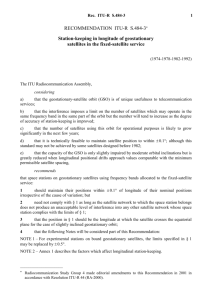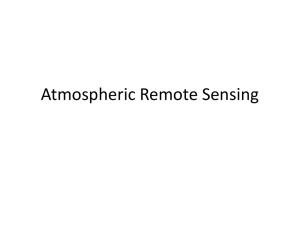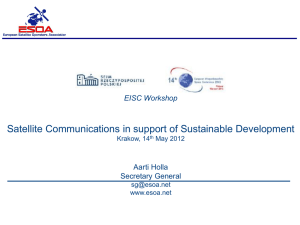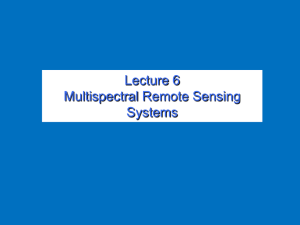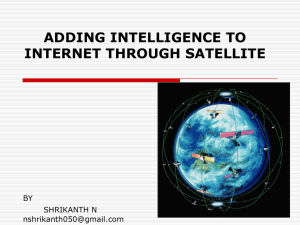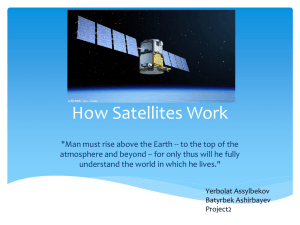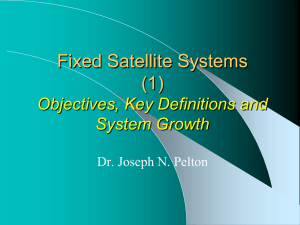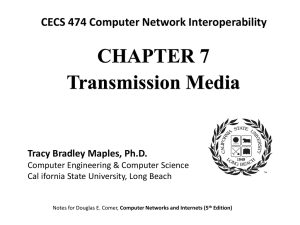SES, Luxembourg
advertisement
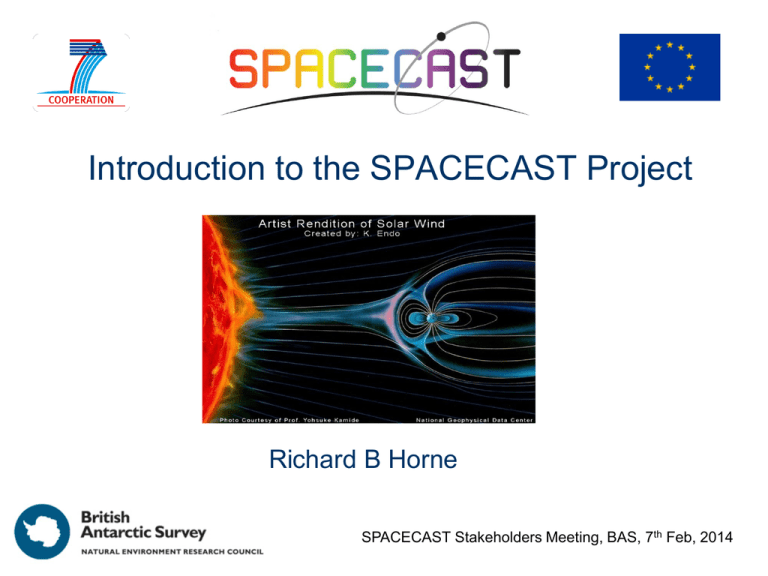
Spacecast Introduction to the SPACECAST Project Richard B Horne SPACECAST Stakeholders Meeting, BAS, 7th Feb, 2014 Space Weather • Changes that occur in near-Earth space which can disrupt modern technology UK National Risk Register of Civil Emergencies • Severe Space Weather Satellite Anomalies – Related to space Weather • • • • • • 20th Jan 1994 – Intelsat 4, Anik E1 and Anik E2 – Intelsat 4 and Anik E1 were recovered in a few hours – Anik E2 - Loss of service for 6 months 11th January 1997 – Telstar 401 - Total loss – Insurance payout $132m 19th May 1998 – Galaxy IV - Total loss – Insurance payout $165m 23rd Oct to 6th Nov 2003 – 47 satellites reported malfunctions – 10 satellites – loss of service for more than 1 day – Midori 2 - Total loss - US$640m – scientific satellite 5th Apr 2010 – Galaxy 15 - Loss of service for 8 months - drifted around GEO – risk of collision 7th March 2012, – Sky Terra 1 and Spaceway 3 - Safe mode, loss of service for hours - days SPACECAST - The Goal Satellites • Radiation Belts Solar Energetic Particles Goal – To protect space assets from high and low energy particles by developing European dynamic modelling and forecasting capabilities The SPACECAST Team BAS U. of Helsinki Johns Hopkins UCLA K. U. of Leuven FMI NASA Goddard DH Consultancy Los Alamos U. of Barcelona ONERA Stakeholder - SES, Luxembourg Exploration Physics Inc. And many other international collaborations common for research projects Satellite Orbits and the Electron Radiation Belts Wave-Particle Interactions Satellite observations Antarctic observations • • • Wave-particle interactions cause electron acceleration and loss Cause variability Changed ideas lasting 40 years Waves and Particles Kind permission of Andy Kale and Ian Mann, U. of Alberta Forecasting Concept ACE satellite Radiation Belts • It takes ~ 40-60 minutes for the solar wind to flow from the ACE satellite to the Earth • Access ACE satellite data in real time and use it to drive our forecasting models • We use physical models – Like weather forecasting Achievements – Forecast of >800 keV electrons Model 3 hour model forecast • Whole outer radiation belt • GEO, MEO, slot region • Forecast turned into risk of internal charging • 24/7 • Automatic GOES satellite data Risk of Internal Satellite Charging - ESD • • Model results are converted into a risk index Risk levels are based on previous satellite anomalies at geostationary orbit GOES 13 Model Achievements – Nowcast of Low Energy (40 keV) Electrons Cause of surface charging on satellites Data Model Achievements – Risk of Surface Charging • • Model results are converted into a risk index Risk levels are based on electron flux and satellite charging at geostationary orbit Achievements – Solar Energetic Particle Events • • • Captured the evolution of the shock and the magnetic connection between Earth and the shock – the cobpoint Developed better model of foreshock acceleration – by turbulence Will enable better empirical models of SEP events Achievements – Radiation Dose at Geostationary Orbit • The measured proton flux at geostationary orbit is converted into a dose rate and displayed in real time Achievements – Stakeholders • SPACECAST has developed strong stakeholder interest • • • • • • SES (Luxembourg) Atrium Insurance (UK) Surrey Satellites (Astrium UK) Eumetsat (Germany) Lockheed Martin (USA) USA – UK collaboration • Policy advice to Government • • • • Briefing to NATO MPs Evidence to UK House of Commons, briefing MPs, Cabinet Office Cttee National risk register Severe space weather – input to Royal Academy of Engineering Report • Press and publications • • 3 press releases, 2 TV documentary, 3 radio and podcasts, many press articles 15 research papers in peer reviewed Journals Summary • Delivered new research and understanding • Wave-particle interactions control radiation belt variability – VLF, ULF waves • Solar wind controls the transport of low energy electrons • Proton acceleration by wave turbulence at interplanetary shocks • The magnetic connection between the Earth and the shock is essential • Setup the first system to forecast the whole outer radiation belt – up to 3 hours ahead • Geostationary orbit • Medium Earth orbit • ‘Slot’ region (the region between the inner and outer belts) • In real time - Quantify the risk of • internal satellite charging • surface charging • solar proton related damage • 24 hours a day, 7 days a week Discussion • • • What are the most useful results? How do they compare against other offerings? How reliable are NOAA data? • • • How important is satellite anomaly cause and resolution Inner radiation belt? Severe Space Weather events? • Forecasting – who needs it? how far ahead? • Other orbits – Medium, Low, slot region? How well provisioned? • New technology – All electric propulsion – radiation levels – risk levels? Sunspot Cycle – Geomagnetic Activity • active sun quiet sun • • The number of geomagnetic storms is highest 1-2 years after sunspot maximum Risk is higher during magnetic storms So expect higher risk for 2014 - 2018



